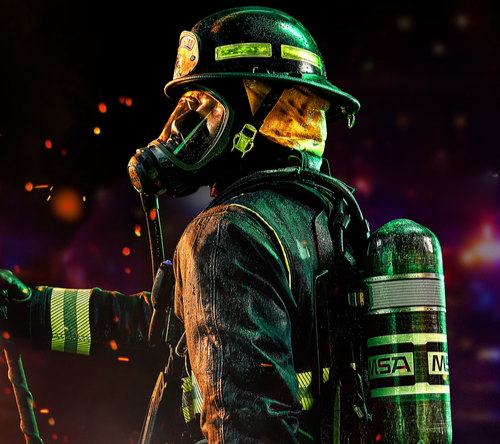
Do firefighters in the U.S. fully recognize the benefits of post-fire cleaning and decontamination of themselves and their equipment to reduce the risk of developing cancer? Common wisdom would say yes, given the amount of information that’s been promulgated by fire service organizations like the IAFC and IAFF as well as non-fire service organizations like the Fire Fighter Cancer Foundation and the Firefighter Cancer Support Network.
Firefighter cancer awareness is not enough
In 2018, T.R. Harrison and his colleagues, collected data for a research study to see how well firefighters were using their knowledge of the risk (awareness) and changing their work behaviors and practices to the desired results (those identified as reducing the cancer risk). The researchers surveyed 482 firefighters from four Florida fire departments examining their attitudes, norms and perceived barriers to field decontamination processes. Here’s a snapshot of the findings:
“Overall, firefighters reported positive attitudes, beliefs, and perceived norms about decontamination, but showering after a fire was the only decontamination process that occurred regularly, with field decontamination, use of cleansing wipes, routine gear cleaning, and other behaviors all occurring less frequently. Firefighters reported time and concerns over wet gear as barriers to decontamination.”
The study’s results showed that while firefighter attitudes were overwhelmingly favorable toward cleaning gear (knowledge), their actual decontamination and cleaning behaviors (doing) did not follow at the same level. This is somewhat like the divergence between attitude and behavior in other areas of health and safety concern, such as public attitudes and behaviors related to using a phone to talk or text while driving.
Firefighter decontamination
One of the major pushes in firefighter decontamination has been reducing the absorption of toxic and carcinogenic particles through the skin. Gross decontamination after exiting the hazard area, prompt removal of PPE, and cleaning skin on the head and neck have been identified as ways to reduce that source of contamination.
Perhaps more importantly, the prompt showering (within an hour) upon arrival back at the fire station with a change into clean clothes has been identified as the desired result. But Harrison and his researchers found that only 64% of the firefighters in the survey reported showering within an hour. More alarmingly, 10% of the surveyed firefighters reported that they never showered after a fire or rarely did so.
Harrison and his team also found that other proactive approaches to firefighter decontamination at the emergency scene (e.g., protective hood swaps and gross decontamination for everyone who worked in the hazard area) were still considered to be a “new” practice and had not been widely adopted.
Cleaning turnout gear
While those study findings may cause one to scratch their head, here’s another one that will have you wondering, “What are they thinking?”
Take the routine cleaning of bunker gear back at the station following interior structural firefighting—should be a standard practice in every fire department, right? So, why did only 72 of those 482 firefighters surveyed (15%) say that they routinely cleaned their PPE back at the station following a fire?
Firefighters participating in the survey indicated high levels of concern about the time it took to launder gear (e.g., only one washer/extractor at a station) and the negative impact of having wet gear (because they only had one set of PPE) on job performance (wet gear is harder to don and increases the potential for steam burns when worn during a subsequent fire).
Changing firefighter attitudes and behaviors for compliance
The article, How to increase firefighter PPE and SCBA compliance, is relevant to this discussion. Replace all references to “firefighters not complying with standard operating guidelines (SOGs) regarding proper use of their PPE and SCBA” with “firefighters not doing what they need to do to protect themselves from exposures to toxins and carcinogens,” you’ll see that they are two sides of the same coin.
Most of us think of progress or improvement as the spread of enlightened thinking: Give people the information, provide some training, and the problem is solved. In the fire service culture, where so much emphasis is placed on education and training for skills development, we’ve come to believe that to change the culture of a fire department, we can do it by appealing to the sense of right and wrong in our people (e.g., who wouldn’t want to protect themselves from cancer?).
But if we really want to make meaningful and lasting improvements in the fire service culture, we may gain more ground by stopping our efforts at tapping into people’s desire to be good or virtuous. Rather, we should focus on something less lofty and, quite frankly, harder to admire: an individual’s powerful drive to fit in with the current and “accepted” cultural norms.
Here are two powerful tools from How to increase firefighter PPE and SCBA compliance for fire department leaders:
- Support a firefighter’s individual will. When an individual firefighter’s knowledge of occupational risk compels them to comply with measures to reduce exposure to chemicals, chemical compounds and carcinogens, despite these other pressures, it’s because of their individual will.Fire department leaders can strengthen an individual’s will by regularly providing good training and education on safety practices and the potential risks of their work. Firefighters who truly understand the what, why and how regarding these new procedures and work practices—to protect them from exposure to toxic materials and carcinogens—are better prepared to resist negative pressure from others who choose not to comply.
- Lead by example. Fire department leaders—from the company officer to the fire chief—should always comply with measures to reduce exposures to toxins and carcinogens when they’re on the scene and back at the fire station.The study group that looked at why firefighters don’t comply with PPE and SCBA policies learned that firefighters are more inclined to wear their PPE when leaders set a personal example by wearing their own PPE. They found that organizational solidarity was a powerful tool for showing that those leaders promote and embrace the organization’s safety policies.
So, while we know that firefighters’ knowledge may not always translate into action, we as leaders must also understand that the new habits are not formed overnight. In fact, James Clear reports that, “on average, it takes more than 2 months before a new behavior becomes automatic—66 days to be exact. And how long it takes a new habit to form can vary widely depending on the behavior, the person, and the circumstances.”
Thus, for these key behaviors necessary to reduce the risks associated with interior structural firefighting to become the new habits, first-line leaders (e.g., company officers) must set the stage and model the correct behavior, and most importantly, be persistent. As one of my mentors frequently said, “The company officer must be unyielding when it comes to the safety and welfare of our people.”
Also know that there are multiple approaches to impact their behaviors to better protect themselves. Key to this is understanding individual drives and the importance of individual will.
The views of the author do not necessarily reflect those of the sponsor
References
Avsec, R. P. (2014, July 31). Changing the Fire Service Culture. Retrieved from Talking “Shop” 4 Fire and EMS: http://www.fireemsleaderpro.org/2014/07/31/changing-fire-service-culture/
Clear, J. (2018, June 14). How Long Does it Actually Take to Form a New Habit? (Backed by Science). Retrieved from James Clear: https://jamesclear.com/new-habit.
Harrison, T. R., Wendorf Muhamad, J., Yang, F., Morgan, S. E., Talavera, E., Caban-Martinez, A., & Kobetz, N. (2018). Firefighter attitudes, norms, beliefs, barriers, and behaviors toward post-fire decontamination processes in an era of increased cancer risk. Journal of Occupational and Environmental Hygiene, 15(4), 279-284.






